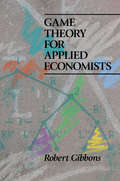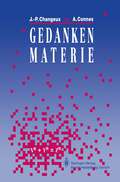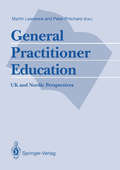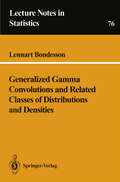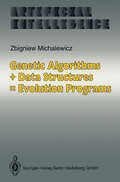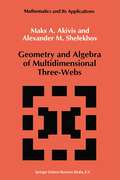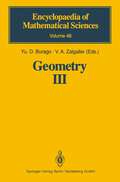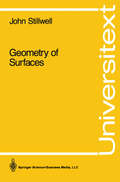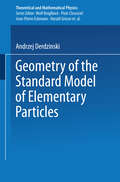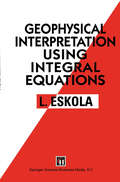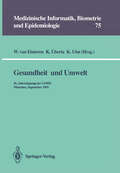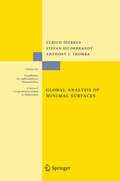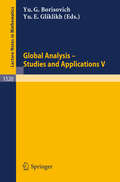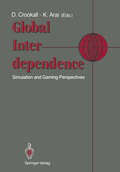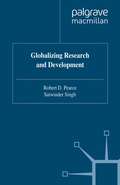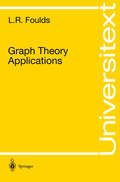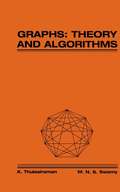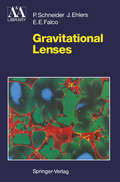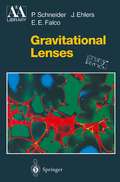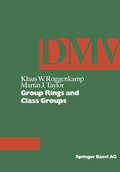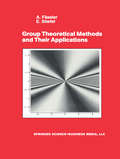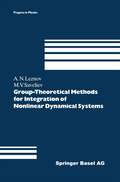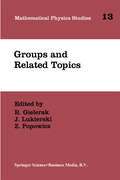- Table View
- List View
Game Theory for Applied Economists
by Robert GibbonsThis book introduces one of the most powerful tools of modern economics to a wide audience: those who will later construct or consume game-theoretic models. Robert Gibbons addresses scholars in applied fields within economics who want a serious and thorough discussion of game theory but who may have found other works overly abstract. Gibbons emphasizes the economic applications of the theory at least as much as the pure theory itself; formal arguments about abstract games play a minor role. The applications illustrate the process of model building--of translating an informal description of a multi-person decision situation into a formal game-theoretic problem to be analyzed. Also, the variety of applications shows that similar issues arise in different areas of economics, and that the same game-theoretic tools can be applied in each setting. In order to emphasize the broad potential scope of the theory, conventional applications from industrial organization have been largely replaced by applications from labor, macro, and other applied fields in economics. The book covers four classes of games, and four corresponding notions of equilibrium: static games of complete information and Nash equilibrium, dynamic games of complete information and subgame-perfect Nash equilibrium, static games of incomplete information and Bayesian Nash equilibrium, and dynamic games of incomplete information and perfect Bayesian equilibrium.
Game Theory for Applied Economists
by Robert GibbonsThis book introduces one of the most powerful tools of modern economics to a wide audience: those who will later construct or consume game-theoretic models. Robert Gibbons addresses scholars in applied fields within economics who want a serious and thorough discussion of game theory but who may have found other works overly abstract. Gibbons emphasizes the economic applications of the theory at least as much as the pure theory itself; formal arguments about abstract games play a minor role. The applications illustrate the process of model building--of translating an informal description of a multi-person decision situation into a formal game-theoretic problem to be analyzed. Also, the variety of applications shows that similar issues arise in different areas of economics, and that the same game-theoretic tools can be applied in each setting. In order to emphasize the broad potential scope of the theory, conventional applications from industrial organization have been largely replaced by applications from labor, macro, and other applied fields in economics. The book covers four classes of games, and four corresponding notions of equilibrium: static games of complete information and Nash equilibrium, dynamic games of complete information and subgame-perfect Nash equilibrium, static games of incomplete information and Bayesian Nash equilibrium, and dynamic games of incomplete information and perfect Bayesian equilibrium.
General Practitioner Education: UK and Nordic Perspectives
by Martin Lawrence and Peter PritchardA workshop to look at strategies, methods of implementation and evaluation of vocational training and Continuing Medical Education in General Practice was held in June 1990 in London. This text represents papers written by contributors to the workshop and pre-circulated papers which describe health systems and educational realities in six countries: Denmark, Finland, Iceland, Norway, Sweden and the UK. The first part of the books compares the structure care systems and General Practice education in the UK and Nordic countries. The second part reviews teaching under five headings, each introduced by a brief commmentary highlighting the main issues and indicating the consensus view. Of particular note is the last chapter which presents demography and health service organization, arrangements for General Practice and primary health care, vocational (specialists) training of GPs, and continuing medical education for each of the six countries.
Generalized Gamma Convolutions and Related Classes of Distributions and Densities (Lecture Notes in Statistics #76)
by Lennart BondessonGeneralized Gamma convolutions were introduced by Olof Thorin in 1977 and were used by him to show that, in particular, the Lognormal distribution is infinitely divisible. After that a large number of papers rapidly appeared with new results in a somewhat random order. Many of the papers appeared in the Scandinavian Actuarial Journal. This work is an attempt to present the main results on this class of probability distributions and related classes in a rather logical order. The goal has been to be on a level that is not too advanced. However, since the field is rather technical, most readers will find difficult passages in the text. Those who do not want to visit a mysterious land situated between the land of probability theory and statistics and the land of classical analysis should not look at this work. When some years ago I submitted a survey to a journal it was suggested by the editor, K. Krickeberg, that it should be expanded to a book. However, at that time I was rather reluctant to do so since there remained so many problems to be solved or to be solved in a smoother way than before. Moreover, there was at that time some lack of probabilistic interpretations and applications. Many of the problems are now solved but still it is felt that more applications than those presented in the work could be found.
Genetic Algorithms + Data Structures = Evolution Programs (Artificial Intelligence)
by Zbigniew Michalewicz'What does your Master teach?' asked a visitor. 'Nothing,' said the disciple. 'Then why does he give discourses?' 'He only points the way - he teaches nothing.' Anthony de Mello, One Minute Wisdom During the last three decades there has been a growing interest in algorithms which rely on analogies to natural processes. The emergence of massively par allel computers made these algorithms of practical interest. The best known algorithms in this class include evolutionary programming, genetic algorithms, evolution strategies, simulated annealing, classifier systems, and neural net works. Recently (1-3 October 1990) the University of Dortmund, Germany, hosted the First Workshop on Parallel Problem Solving from Nature [164]. This book discusses a subclass of these algorithms - those which are based on the principle of evolution (survival of the fittest). In such algorithms a popu lation of individuals (potential solutions) undergoes a sequence of unary (muta tion type) and higher order (crossover type) transformations. These individuals strive for survival: a selection scheme, biased towards fitter individuals, selects the next generation. After some number of generations, the program converges - the best individual hopefully represents the optimum solution. There are many different algorithms in this category. To underline the sim ilarities between them we use the common term "evolution programs" .
Geometry and Algebra of Multidimensional Three-Webs (Mathematics and its Applications #82)
by M. Akivis A.M. ShelekhovGeometry III: Theory of Surfaces (Encyclopaedia of Mathematical Sciences #48)
by Yu D. Burago V. A. ZalgallerA volume devoted to the extremely clear and intrinsically beautiful theory of two-dimensional surfaces in Euclidean spaces. The main focus is on the connection between the theory of embedded surfaces and two-dimensional Riemannian geometry, and the influence of properties of intrinsic metrics on the geometry of surfaces.
Geometry of Surfaces (Universitext)
by John StillwellThe geometry of surfaces is an ideal starting point for learning geometry, for, among other reasons, the theory of surfaces of constant curvature has maximal connectivity with the rest of mathematics. This text provides the student with the knowledge of a geometry of greater scope than the classical geometry taught today, which is no longer an adequate basis for mathematics or physics, both of which are becoming increasingly geometric. It includes exercises and informal discussions.
Geometry of the Standard Model of Elementary Particles (Theoretical and Mathematical Physics)
by Andrzej DerdzinskiThe book gives an exposition of the standard model of elementary particles based on coordinate-free differential geometric foundations. It addresses students in physics and mathematics.
Geophysical Interpretation using Integral Equations
by L. EskolaAlong with the general development of numerical methods in pure and applied to apply integral equations to geophysical modelling has sciences, the ability improved considerably within the last thirty years or so. This is due to the successful derivation of integral equations that are applicable to the modelling of complex structures, and efficient numerical algorithms for their solution. A significant stimulus for this development has been the advent of fast digital computers. The purpose of this book is to give an idea of the principles by which boundary-value problems describing geophysical models can be converted into integral equations. The end results are the integral formulas and integral equations that form the theoretical framework for practical applications. The details of mathematical analysis have been kept to a minimum. Numerical algorithms are discussed only in connection with some illustrative examples involving well-documented numerical modelling results. The reader is assu med to have a background in the fundamental field theories that form the basis for various geophysical methods, such as potential theory, electromagnetic theory, and elastic strain theory. A fairly extensive knowledge of mathematics, especially in vector and tensor calculus, is also assumed.
Gesundheit und Umwelt: 36. Jahrestagung der GMDS München, 15. – 18. September 1991 (Medizinische Informatik, Biometrie und Epidemiologie #75)
by Wilhelm Van Eimeren Karl Überla Kurt UlmGesundheitsberichterstattung und Public health in Deutschland
by Ulrich Laaser Friedrich W. SchwartzGlobal Analysis of Minimal Surfaces (Grundlehren der mathematischen Wissenschaften #341)
by Ulrich Dierkes Stefan Hildebrandt Anthony TrombaMany properties of minimal surfaces are of a global nature, and this is already true for the results treated in the first two volumes of the treatise. Part I of the present book can be viewed as an extension of these results. For instance, the first two chapters deal with existence, regularity and uniqueness theorems for minimal surfaces with partially free boundaries. Here one of the main features is the possibility of "edge-crawling" along free parts of the boundary. The third chapter deals with a priori estimates for minimal surfaces in higher dimensions and for minimizers of singular integrals related to the area functional. In particular, far reaching Bernstein theorems are derived. The second part of the book contains what one might justly call a "global theory of minimal surfaces" as envisioned by Smale. First, the Douglas problem is treated anew by using Teichmüller theory. Secondly, various index theorems for minimal theorems are derived, and their consequences for the space of solutions to Plateau´s problem are discussed. Finally, a topological approach to minimal surfaces via Fredholm vector fields in the spirit of Smale is presented.
Global Analysis - Studies and Applications V (Lecture Notes in Mathematics #1520)
by Yuri G. Borisovich Yuri E. GliklikhThis volume (a sequel to LNM 1108, 1214, 1334 and 1453) continues the presentation to English speaking readers of the Voronezh University press series on Global Analysis and Its Applications. The papers are selected fromtwo Russian issues entitled "Algebraic questions of Analysis and Topology" and "Nonlinear Operators in Global Analysis". CONTENTS: YuE. Gliklikh: Stochastic analysis, groups of diffeomorphisms and Lagrangian description of viscous incompressible fluid.- A.Ya. Helemskii: From topological homology: algebras with different properties of homological triviality.- V.V. Lychagin, L.V. Zil'bergleit: Duality in stable Spencer cohomologies.- O.R. Musin: On some problems of computational geometry and topology.- V.E. Nazaikinskii, B.Yu. Sternin, V.E.Shatalov: Introduction to Maslov's operational method (non-commutative analysis and differential equations).- Yu.B. Rudyak: The problem of realization of homology classes from Poincare up to the present.- V.G. Zvyagin, N.M. Ratiner: Oriented degree of Fredholm maps of non-negativeindex and its applications to global bifurcation of solutions.- A.A. Bolibruch: Fuchsian systems with reducible monodromy and the Riemann-Hilbert problem.- I.V. Bronstein, A.Ya. Kopanskii: Finitely smooth normal forms of vector fields in the vicinity of a rest point.- B.D. Gel'man: Generalized degree of multi-valued mappings.- G.N. Khimshiashvili: On Fredholmian aspects of linear transmission problems.- A.S. Mishchenko: Stationary solutions of nonlinear stochastic equations.- B.Yu. Sternin, V.E. Shatalov: Continuation of solutions to elliptic equations and localisation of singularities.- V.G. Zvyagin, V.T. Dmitrienko: Properness of nonlinear elliptic differential operators in H|lder spaces.
Global Interdependence: Simulation and Gaming Perspectives Proceedings of the 22nd International Conference of the International Simulation and Gaming Association (ISAGA) Kyoto, Japan: 15–19 July 1991
by J. C. Hilbun B. F. HarrisThis volume records the proceedings of the 22nd Annual International Con ference of the International Simulation and Gaming Association (ISAGA), 15-19 July, 1991, Kyoto, Japan, sponsored by the Science Council of Japan and the Japanese Association of Simulation and Gaming (JASAG). The con ference theme was Global Modeling for Solving Global Problems. The first 2 days of the conference were held in the magnificent Kyoto International Conference Hall; the 3rd day was spent admiring the floats of the famous Gion Festival in the exquisite city of Kyoto and the Daibutsu (or Great Buddha) of the Todaiji Temple in Nara and visiting one of the Sharp factories. During the last 2 days of the conference we were made most welcome in the Faculty of International Relations of Ritsumeikan University. The day after the conference, a number of delegates went to Hiroshima (the Peace Memorial Hall, Museum and Park) and also to one of Japan's "Scenic Trio," the island of Miyajima with its breathtaking views and the Itsukushima Shrine. The conference was attended by some 400 delegates from over 30 different countries. Over 100 sessions, both theoretical and practical, were given: keynote speeches, round-table discussions, workshops, papers. This volume reflects most of those sessions, in the form of either a full paper or a short abstract.
Globalizing Research and Development (University of Reading European and International Studies)
by R. Pearce S. SinghThe book uses interview and survey information from 300 of the world's leading industrial enterprises to provide an in-depth investigation of the issues relating to the internationalisation of R & D by multinational enterprises. The viewpoints of central coordinating R & D units and their overseas subsidiaries are analysed. The issues covered include the nature and funding of the work done in overseas facilities; the specialisation of roles in globalised R & D; coordination practices; sources of ideas implemented in R & D programmes and attitudes to government policies.
Graph Theory Applications (Universitext)
by L.R. FouldsThe first part of this text covers the main graph theoretic topics: connectivity, trees, traversability, planarity, colouring, covering, matching, digraphs, networks, matrices of a graph, graph theoretic algorithms, and matroids. These concepts are then applied in the second part to problems in engineering, operations research, and science as well as to an interesting set of miscellaneous problems, thus illustrating their broad applicability. Every effort has been made to present applications that use not merely the notation and terminology of graph theory, but also its actual mathematical results. Some of the applications, such as in molecular evolution, facilities layout, and graffic network design, have never appeared before in book form. Written at an advanced undergraduate to beginning graduate level, this book is suitable for students of mathematics, engineering, operations research, computer science, and physical sciences as well as for researchers and practitioners with an interest in graph theoretic modelling.
Graphs: Theory and Algorithms
by K. Thulasiraman M. N. SwamyThis adaptation of an earlier work by the authors is a graduate text and professional reference on the fundamentals of graph theory. It covers the theory of graphs, its applications to computer networks and the theory of graph algorithms. Also includes exercises and an updated bibliography.
Gravitational Lenses (Astronomy and Astrophysics Library)
by Peter Schneider Jürgen Ehlers Emilio E. FalcoThe theory, observations, and applications ofgravitational lensingconstitute one ofthe most rapidly growing branches ofextragalactic astrophysics. The deflection of light from very distant sources by intervening masses provides a unique possibility for the investigation of both background sources and lens mass distributions. Gravitational lensing manifestsitselfmost distinctly through multiply imaged QSOs and the formation of highly elongated im ages of distant galaxies ('arcs') and spectacular ring-like images of extra galactic radio sources. But the effects of gravitational light deflection are not limited to these prominent image configurations; more subtle, since not directly observable, consequences of lensing are the, possibly strong, mag nification of sources, which may permit observation of intrinsically fainter, or more distant, sources than would be visible without these natural tele scopes. Such light deflection can also affect the source counts of QSOs and of other compact extragalactic sources, and can lead to flux variability of sources owing to propagation effects. Trying to summarizethe theory and observationalstatus ofgravitational lensing in a monograph turned out to be a bigger problem than any of the authors anticipated when we started this project at the end of 1987, encour aged by Martin Harwit, who originally approached us. The development in the field has been very rapid during the last four years, both through the ory and through observation, and many sections have been rewritten several times, as the previous versions became out of date.
Gravitational Lenses (Astronomy and Astrophysics Library)
by P. Schneider J. Ehlers E.E. FalcoLight observed from distant objects is found to be deflected by the gravitational field of massive objects near the line of sight - an effect predicted by Einstein in his first paper setting forth the general theory of relativity, and confirmed by Eddington soon afterwards. If the source of the light is sufficiently distant and bright, and if the intervening object is massive enough and near enough to the line of sight, the gravitational field acts like a lens, focusing the light and producing one or more bright images of the source. This book, by renowned researchers in the field, begins by discussing the basic physics behind gravitational lenses: the optics of curved space-time. It then derives the appropriate equations for predicting the properties of these lenses. In addition, it presents up-to-date observational evidence for gravitational lenses and describes the particular properties of the observed cases. The authors also discuss applications of the results to problems in cosmology.
Group-Theoretical Methods for Integration of Nonlinear Dynamical Systems (Progress in Mathematical Physics #15)
by Andrei N. Leznov Mikhail V. SavelievThe book reviews a large number of 1- and 2-dimensional equations that describe nonlinear phenomena in various areas of modern theoretical and mathematical physics. It is meant, above all, for physicists who specialize in the field theory and physics of elementary particles and plasma, for mathe maticians dealing with nonlinear differential equations, differential geometry, and algebra, and the theory of Lie algebras and groups and their representa tions, and for students and post-graduates in these fields. We hope that the book will be useful also for experts in hydrodynamics, solid-state physics, nonlinear optics electrophysics, biophysics and physics of the Earth. The first two chapters of the book present some results from the repre sentation theory of Lie groups and Lie algebras and their counterpart on supermanifolds in a form convenient in what follows. They are addressed to those who are interested in integrable systems but have a scanty vocabulary in the language of representation theory. The experts may refer to the first two chapters only occasionally. As we wanted to give the reader an opportunity not only to come to grips with the problem on the ideological level but also to integrate her or his own concrete nonlinear equations without reference to the literature, we had to expose in a self-contained way the appropriate parts of the representation theory from a particular point of view.
Groups and Related Topics: Proceedings of the First Max Born Symposium (Mathematical Physics Studies #13)
by R. Gielerak J. Lukierski Z. PopowiczIn the seventies and eighties, scientific collaboration between the Theory Section of the Physics Department of Leipzig University and the Institute of Theoretical Physics of the University of Wroolaw was established. This manifested itself, among other things, in the organization of regular, twice-yearly seminars located alternatively in Wrodaw and Leipzig. These Seminars in Theoretical Physics took place 27 times, the last during November 1990. In order to continue the traditions of German-Polish contacts in theoretical physics, we decided to start a new series of Seminars in Theoretical Physics and name them after the outstanding German theoretical physicist Max Born who was born in 1883 in Wrodaw. We hope that these seminars will continue to contribute to better scientific contacts and understanding between German and Polish theoretical physicists. The First Max Born Symposium was held in Wojnowice Castle, 20 km west of Wrodaw, 27 - 29 September 1991. Wojnowice Castle was built in the 16th century by the noble Boner family, in the Renaissance style, and has been recently adapted as a small conference center. The preferred subjects at the Symposium were Quantum Groups and Integrable Models. The Symposium was organized by Doctors R. Gielerak and Z. Popowicz under the scientific supervision of the undersigned.
